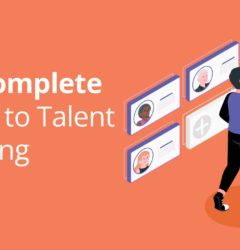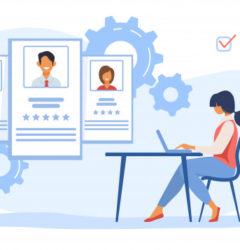
The Ultimate Recruiter’s Guide to Video Interviewing
Video interviewing has gone mainstream. Not too long ago, it was used sparingly as a tool to interview candidates from abroad and screen large applicant pools. Now, it’s difficult to find a job without a video interviewing process. In fact, a poll of HR professionals found that around 86% of businesses are now using virtual technology to interview candidates.
This guide will explore the benefits of video interviewing and show you how to implement it successfully.
What is video interviewing?
Put simply, a video interview is a job interview conducted online. Both the interviewer and the interviewee log into a video conferencing app and the interview is conducted remotely. Many hiring managers claim that this process is more efficient and more effective than in-person interviews.
Also, check Top 7+ Video Interview Software in 2021 [Free + Paid]
Why use video interviewing?
There are plenty of reasons to use video interviewing. It makes the hiring process easier and more efficient. Plus, there are some hidden benefits that you probably hadn’t thought of. Here’s why you should use video interviewing.
Reduces hiring time
Recruitment is a time-consuming process. Every job post can attract hundreds of applicants. That means hiring managers have to sift through a huge number of resumes and cover letters before they even reach the interview stage. Conducting video interviews can reduce their time to hire significantly.
Access to global candidates
One of the biggest benefits of video interviewing is access to a global talent pool of candidates. If a company decides to only conduct in-person interviews, they are putting a geographical restriction on their candidate pool. Top tech talent may be willing to relocate from across the globe to work for your company but they probably can’t make the same trip just for an interview.
Test video presentation skills
Video conferencing is a large part of any modern business. From conducting remote meetings to recording presentations, it’s a useful tool that will become even more commonplace in the next decade. That means businesses will need employees that are comfortable using video conferencing software. Video interviewing is a great way to test their skills.
Record and rewatch interviews
Interviewing candidates can be a tiring process. After hours of asking the same questions and hearing similar responses, interviewers are going to experience fatigue.
That’s why it’s extremely useful to record and rewatch interviews. You can record split-screen videos to show cause and effect, which can help you as a recruiter to understand how candidates react to different situations and how they solve problems. This will help you pick between candidates and analyze their interview performance with better accuracy. You can even implement speech recognition software to help you dictate the interview and automatically transcribe it into a document. This gives you the option to read responses instead of listening to them.
Also, check Recruitment Automation: 7 Ways to Improve Your Hiring Process
Decrease hiring costs
By reducing the time to hire, video interviewing also decreases hiring costs. You can screen a large number of candidates and then conduct fewer in-person interviews.
What are the potential downsides of video interviewing?
Video interviews might seem like the perfect solution for your hiring process. However, it’s not without its drawbacks. Here are the potential downsides of video interviewing.
Internet connection issues
It’s often assumed that everyone has access to a fast and stable internet connection. But that’s not the case at all.
In fact, around a quarter of Americans have no internet connection at all (see graph below). And, candidates with an internet connection might be stumped by a connection issue. When conducting a video interview, this is one of the most common problems.
Candidates might have issues with tech
Some candidates might have an issue with understanding video interviewing technology. For example, they might not be able to troubleshoot problems with their microphone or speakers. This could have a negative effect on their interview performance and waste the interviewer’s time.
How to set up a successful video interview
The success of video interviewing depends on how well you set it up. You need the right tools, a strong internet connection, and a well-defined process for candidates. Here’s how to set up a successful video interview.
Choose the right tools
The success of a video interview depends on the tools you use. This will include a video conferencing app and an ATS (Applicant Tracking System). This will ease the process of managing applicants and sifting through candidates. RecruiterFlow is one of the most popular examples.
Ensure that you have a strong internet connection
Unfortunately, you can’t control the candidate’s internet connection. However, you can mitigate some risks by ensuring that your internet connection is fast and stable, and by being prepared to troubleshoot connection issues. This is an essential step in ensuring a smooth video interviewing process.
Test your camera and microphone
Before starting the interview process, test your camera and microphone. As well as ensuring that both are working, you should test that the quality is up to scratch. Low-quality audio and video aren’t a good way to represent your brand. You can get help from video marketing agencies to ensure your video interviews are professional and reflect positively on your brand. Usually, any agency, whether it’s D2C or B2B video marketing agency, they have different pricing slabs based on the audio and the video quality.
Brand your interview
A video interview is a two-way street. As well as testing the applicant, you also need to promote your company and the position you’re offering. This is the only way to attract great candidates. One of the most effective ways of doing this is by branding your video interview. Use a personalized virtual background to give candidates a taste of your brand identity.
Explain the process to candidates
To get the most out of candidates, it’s important to put them at ease. To do this, you need to explain the process effectively. If you have a large number of candidates, you could set up an Interactive Voice Response (IVR) – IVR meaning a phone line that utilizes voice commands or telephone keypad tones to provide the candidate with information. This will dramatically cut down on the amount of admin time needed to explain the process to individual applicants.
Tell the candidates the dress code
Candidates should know the dress code beforehand. To keep it simple, it’s best to go for a smart dress code. For men, this means you can wear semi-casual attire like a suit jacket, suit trousers, and a shirt and tie.
Involve your employees in the process
Your current employees are a valuable resource in the hiring process. Not only can they provide an insight into what it’s like to work for the company, but they can also help you sift through applicants. Plus, involving employees in the hiring process is one of the main tips to reduce staff turnover.
How to structure a video interview
The structure of a video interview is similar to an in-person interview. Here’s a basic outline to get you started.
Introduction
Every interview should start with an introduction. During this part, you can explain a little bit about the company, the role you’re hiring for, and what to expect from the interview process. This will give candidates time to settle their nerves and make the interview feel more like a conversation.
If you want to save time during each interview, you could create a virtual tour that promotes your business.
Profile
This is the candidate’s chance to speak about their overall work experience. Many interviewers will ask an open-ended question to start the candidate talking. Examples include:
- Could you tell us a little bit about yourself?
- Can you walk us through your work experience?
Motivations
After the profile section, it makes sense to move on to the candidate’s motivations. In this section, you should ask them open-ended questions like:
- Why do you want to work for our company?
- What is your five-year plan?
- What are your long-term career goals?
The answers to these questions will give you a better idea of the candidate’s personality.
Skills
At this point of the interview, it’s important to focus on tangible skills. Depending on the job role, the candidate will talk about their skill set and how they plan to implement it. If you are hiring an app developer, you could assess their mobile app development skills by asking them to walk you through a recent project they worked on. On top of that, they might talk about how they used their skill set in previous roles.
Technical questions & creative tasks
To test the candidate, it’s important to ask them some technical questions. For example, if you are hiring for an app developer role, you could ask questions like:
- What steps would you take to improve the app retention rate?
- What are the benefits of a hybrid mobile app?
You might also use some unconventional recruitment methods that test the candidate’s creative thinking skills. For example, you could ask them to create a mind map for a project that is relevant to the job role.
Job description & salary
The penultimate section of the interview is a discussion about the job description and salary. As the interviewer, this section is your chance to promote the role and discuss the candidate’s expected salary. It’s important to prepare carefully for this part of the interview.
Final questions & next steps
At the end of the interview, you should ask the candidate if they have any questions. Then, you can explain the next steps.
This might include when they can expect to hear back, how well they have performed, and if they have been successful. Some companies with an Automation COE might choose to automate this part of the video interview.
The bottom line
The rise of video interviewing is showing no signs of slowing down. That means your company needs to get on board and develop a strong video interview culture.
Access to the right tools and careful preparation are the two most important considerations. However, you might need to experiment to achieve the perfect formula.
v
This is a guest post submitted by Severine Hierso, EMEA Senior Product Marketing Manager for RingCentral Office, the leader in cloud communications solutions and ACD systems. She is passionate about creating value, differentiation, and messaging, ensuring a better experience for customers and partners.


